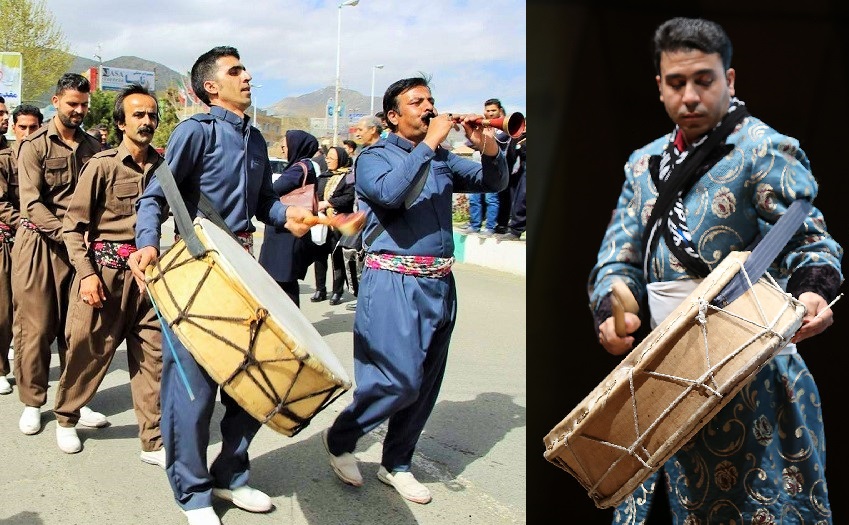Dohol
This instrument is known as Dawl, Dewl, and Dohol in various Kurdish accents.
It belongs to the percussion music instruments. The Dohol player is known as Daholkut, Dewlkut, Dolangew, and Doholjan.
In all the world's cultures, Dohol is being used.
It is a musical instrument played with Sorna and it can be made in different sizes.
The technical level and tutorial needed to learn how to play this instrument in Kurdish culture is much higher than the other ancient cultures of the world.
Dohol and Sorna, as some of the most important musical instruments in Kurdistan, play fundamental roles in Kurdish culture and traditions.

Dohol is made of these parts:
Kama, Chambar, Pest, Guris (rope), Miliguris, Gochan (cane), Toul (Shoul), Qaysh (lace)
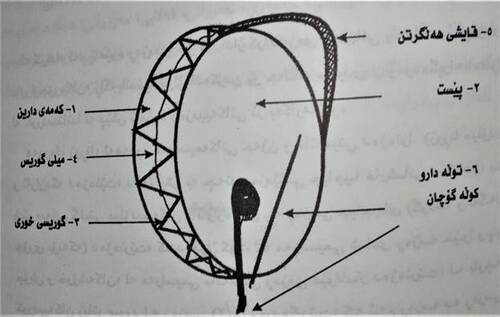
Kama
As well as Daff's Kama, it is bent and shaped into a circle but Dohol's Kama is wider than Daff's.
Kama is made of willow tree, walnut, and berry trees and it is 2 cm thick.
Dohol's Kama is made wider in the Northern part of Kurdistan compared with the southern parts of Kurdistan. It is as wide as 20 to 50 cm.
The circular ring of Kama is about 45 to 65 cm and the Dohols' Kama among Khorasan Kurdish clans and the North part of Kurdistan people is smaller compared to other parts of Kurdistan.
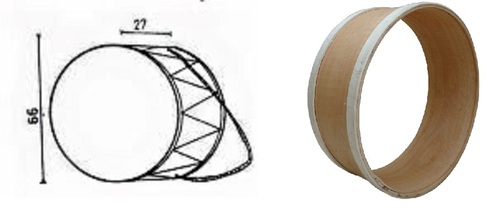
The figure of Dohol's Kama
Chambara
A branch of a willow tree that is grown at the side of the willow tree and can easily be bent because it is very young.
After Chambara is dried, it is tied at the top of Kama on each side of it.
Chambara is used to tighten or loosen the skin of Dohol.
Pest (Skin)
Both sides of Kama are covered with Pest.
Generally, the right part of Kama is covered with Torakh Pest (a skin used in Mashka to make yogurt with), or the skin of sheep or goat.
After the skin used in Mashka is soaked for a while, they cut and wrap it around Chambara, and cover the Kama with it.
The left side of Kama is covered with lambs' or yearlings' skin.
Nowadays, instead of animals' skin, they use plastic covers.
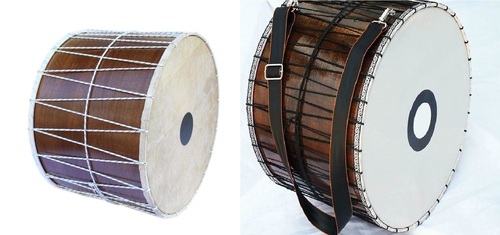
The figure of plastic Dohol
The right side of Dohol's skin is thicker than the left side of it which makes a bass sound and the left side, on the other hand, makes a treble sound since the skin on this side is thinner.
Guris (rope) and Miliguris
Both Chambaras are bent over the Kama after they are covered with the skin. Then they use a rope (Guris) that is spun by women with goats' wool in a zig zag form to tie it firmly.
When the skin and Chambara are joined to the Kama with a rope, another rope will tie the Kama from end to end, and in the middle of it, the left and right ropes will cover the Chambara which is called Miliguris.
Miliguris which is tied to a metal ring to hold it in place will play the main role in tunning the instrument. If Dohol's Kama is longer than 50 cm, they will use two Miliguris for it.
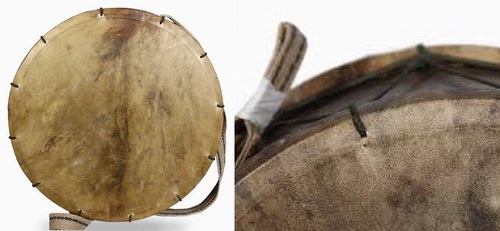
The figure of covering Kama and Chambara with skin and the spot where the rope is being used
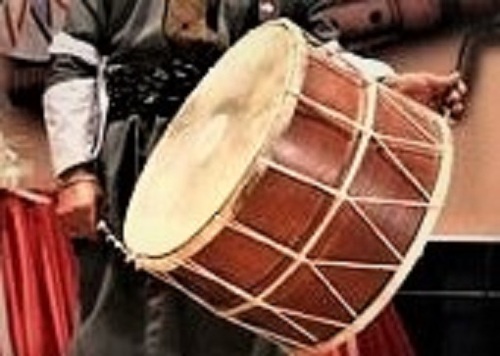
The figure of the rope and Miliguris
It is worth mentioning that in Sna (Sanandaj) they do not use Chambara and rope to fix the skin on Dohol, instead they use glue and paste to fix it just like Daff.
Gochan (cane) and Gurz
A piece of walnut or any other kind of tree's wood as long as 35 to 45 cm that can be made in two ways.
Gochan
It can be made of pear, willow, or European ash tree.
It must be light and well-formed so the music player will not feel tired in a short while. It also needs to be well-polished so that it would not harm the Dohol.
There is another form of making this piece which is made of a walnut tree or pear tree and it is not bent down so it is called Dargochan.
Apart from the southern regions of Zagros (Kamyaran and from Nawdarwand to Lorestan regions), all the other areas of Kurdistan use Gochan to play Dohol.
Gurz
Just like Ramb and Gurz, it has a round end and it is generally made of pear or walnut tree.
Gurz and Gochan are used to hit the right-side skin of Dohol to make a bass sound.
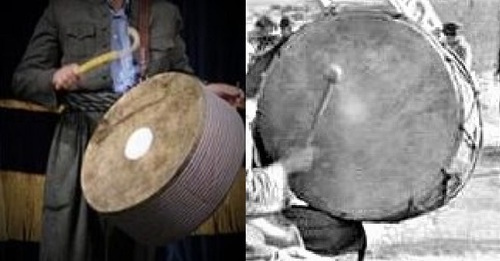
The figure of Gochan and Gurz
Shoul (Toul)
It is made of a thin piece of wood of a pomegranate or almond tree.
Shoul trembles on the Dohol's skin, it cannot be flown away or broken but needs to stay whole.
Shoul is about 40 to 50 cm long.
It is used on the left side to make trebling sounds of Dohol.
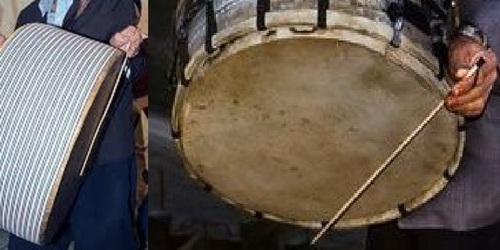
The figure of Shoul (Toul)
Qayshband
In order to keep the instrument in place over the player's shoulder, they use Qaysh (lace).
This lace is made of bull's skin and it is 110 to 130 cm long and 4 to 5 cm wide. It can also be made of fabrics.
Both ends of the Qaysh are fixed with two metal rings on the Kama.
Generally, there are three kinds of Qaysh used for Dohol including:
From right to left or from left to right side.
On one shoulder.
On the elbow and arm.
Figures of holding and carrying Dohol while playing it.
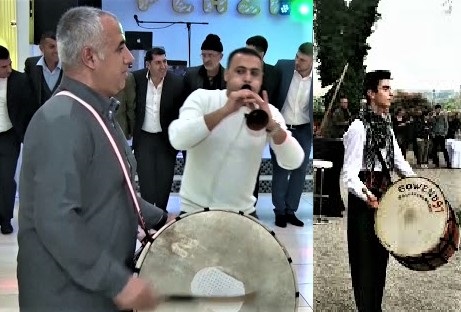
Right to left
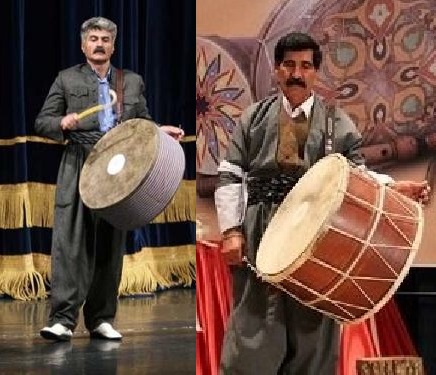
One shoulder
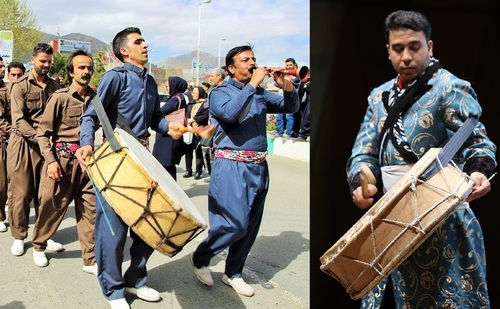
The player's arm

